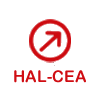Electrochemical Regeneration of LiAlH4
Résumé
Hydrogen, a promising clean energy vector, surpasses traditional fuels in energy content (140 MJ/kg) but faces storage challenges. Aluminum-based complex metal hydrides like LiAlH4 offer solutions with high volumetric (>80g H2/L) and gravimetric (>8 wt %) energy densities, along with low decomposition temperatures (<423 K). However, their synthesis involves costly organometallic reactions and high hydrogenation pressures (>1 kbar). Consequently, a significant interest is in cost-effective approaches for regenerating LiAlH4 from its spent (hydrogen-depleted) material and H2.
Graetz[1] proposed its first chemical regeneration, examining dehydrogenated LiH and Al with a Ti catalyst in THF under high H2 pressure (50 bar). Humphries[2] explored sub-ambient regeneration (<0°C) using Me2O and 95 bar H2. However, their practicality is hindered by reliance on high H2 pressure. Our research group investigates the viability of an electrochemical approach for its regeneration and potential elimination on the use of high H2 pressure, a novel concept not previously reported in the literature..
Electrochemical properties were studied in THF-based electrolyte and Ar atmosphere at RT. Figure 1 shows a cyclic voltammogram of 1M LiAlH4 in THF to which we identified essential reactions, including Li and Al deposition, and irreversible anodic polarization of [AlH4-] associated with H2 release[3]. Applying a constant reduction potential ( -3.10 V vs. standard hydrogen electrode) resulted in dehydrogenated LiAlH4 (Li-Al alloy formation) and H2 release, demonstrating room-temperature electrochemical dehydrogenation with a Faradaic efficiency of 69%. We explore the effect of H2 pressure on these electrochemical reactions using our custom electrochemical pressure cell. The next step involves regenerating the deposited Li-Al alloy under moderate H2 pressures (<10 bar) and applying oxidative potentials to induce [AlH4-] reformation using Pd, Pt, Ti, or Ni electrocatalysts. Reformed LiAlH4 is quantified using 27Al NMR coupled with ICP-MS. Fundamental parameters will be investigated, including its kinetics, diffusion coefficients, and regeneration mechanisms, using various electroanalytical techniques like chronoamperometry, voltammetry, rotating disk electrode, and electrochemical-impedance spectroscopy.
Domaines
Chimie
Fichier principal
 2178+UGADDAN+both+regular+2024-01-04+16-18-09.pdf (119.21 Ko)
Télécharger le fichier
2178+UGADDAN+both+regular+2024-01-04+16-18-09.pdf (119.21 Ko)
Télécharger le fichier
Origine : Fichiers produits par l'(les) auteur(s)




